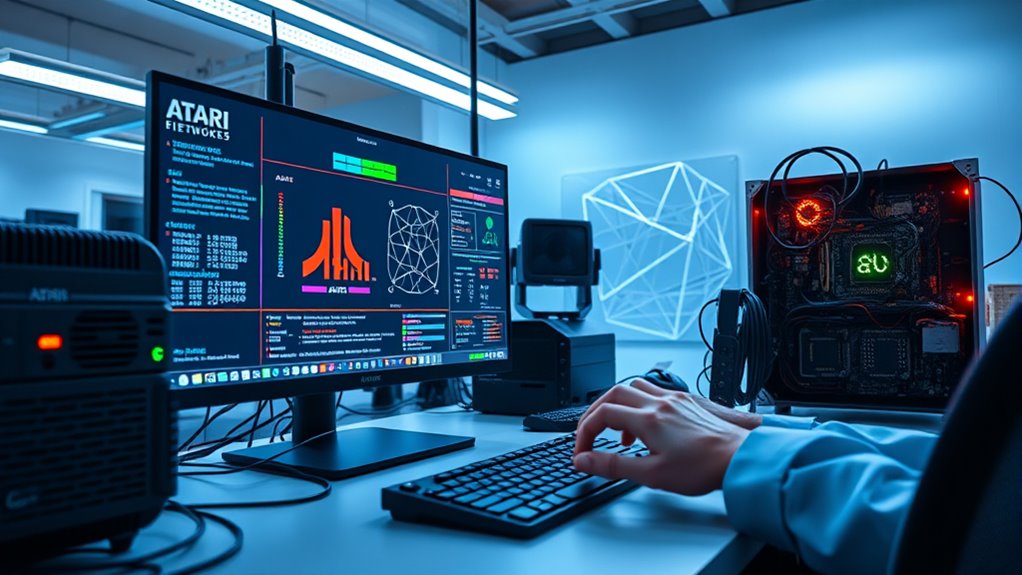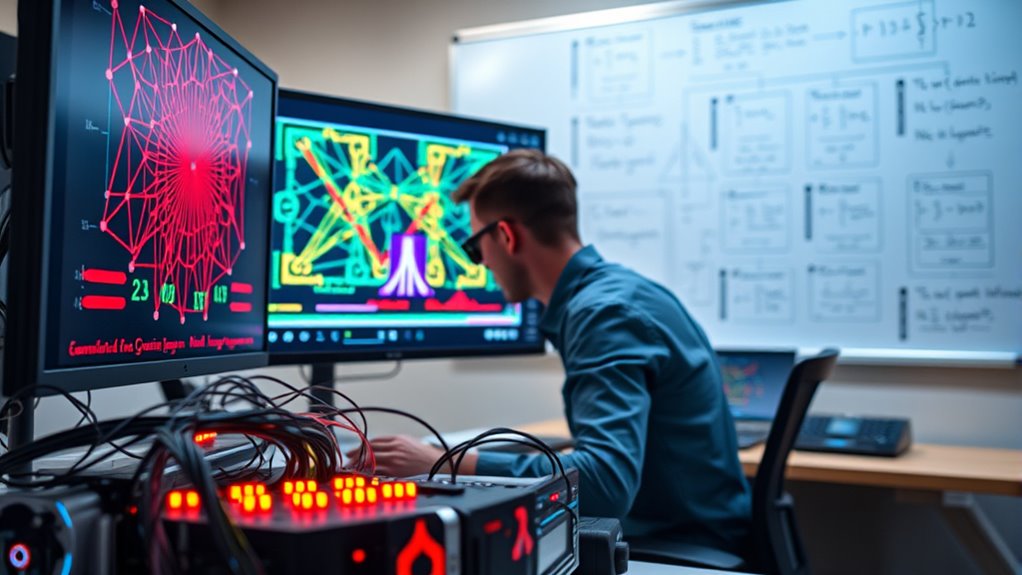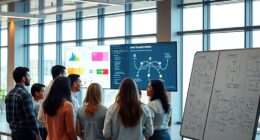Deep Q‑Networks (DQNs) blend reinforcement learning with neural networks, allowing machines to learn complex tasks directly from raw data like images. They work by predicting the best actions in various situations, using experience replay to improve over time. Originally famous for mastering Atari games, DQNs now power applications like robotics, autonomous vehicles, and healthcare. If you want to explore how this powerful approach transforms real-world problem-solving, keep exploring what’s beneath the surface.
Key Takeaways
- Deep Q-Networks (DQNs) use neural networks to estimate optimal actions directly from raw sensory data, like pixels.
- They combine reinforcement learning with deep learning to handle complex, high-dimensional environments such as Atari games.
- DQNs learn by iteratively updating their neural networks based on rewards and experiences stored in replay buffers.
- The technology has been extended beyond gaming to real-world applications like robotics, autonomous vehicles, and healthcare.
- DQNs enable machines to develop adaptive decision-making strategies, transforming AI capabilities across various industries.

Have you ever wondered how computers learn to play complex games or make decisions in dynamic environments? It all comes down to a combination of Reinforcement Learning and neural network architecture. Reinforcement Learning is a type of machine learning where an agent learns to make decisions by interacting with its environment, receiving feedback in the form of rewards or penalties. This process helps the agent develop strategies to maximize cumulative rewards over time. When paired with neural network architecture, this approach becomes incredibly powerful. Neural networks act as function approximators, enabling the system to handle high-dimensional data and complex patterns that traditional algorithms struggle with. This synergy is at the heart of Deep Q-Networks, or DQNs.
Reinforcement learning combined with neural networks enables machines to master complex decision-making tasks.
Deep Q-Networks revolutionized how machines learn from their environment by using neural networks to estimate the optimal action-value function. Instead of relying on tabular methods, which become infeasible with large state spaces, DQNs leverage deep learning to generalize across vast amounts of data. This allows them to process raw sensory inputs, like pixels from an Atari game, and learn directly from the visual data without manual feature extraction. The neural network architecture in DQNs typically consists of convolutional layers that extract features from images, followed by fully connected layers that output Q-values—estimations of how good each possible action is in a given state. This structure enables the model to interpret complex visual information and determine the best move in real time.
Training a Deep Q-Network involves repeatedly playing the game, updating the neural network based on the difference between predicted Q-values and the target Q-values derived from observed rewards. This process, called Q-learning, uses a technique called experience replay, where past experiences are stored and randomly sampled to stabilize learning. The neural network adapts through backpropagation, adjusting weights to improve the accuracy of its Q-value estimates. Over time, this iterative process helps the agent refine its policy, leading to mastery of tasks like Atari games, where it can outperform humans by learning strategies solely from pixel inputs. Recent advances show how AI is capable of developing solutions for complex real-world problems, expanding the scope of applications for Deep Q-Networks.
Beyond gaming, the principles behind Deep Q-Networks have significant real-world applications. From robotics and autonomous vehicles to financial trading and healthcare, these systems enable machines to learn from interaction and optimize decision-making in complex, unpredictable environments. The combination of reinforcement learning with neural network architecture provides the foundation for intelligent systems that can adapt, improve, and operate autonomously—transforming the way machines solve real-world problems.
Frequently Asked Questions
How Do Deep Q-Networks Compare to Other Reinforcement Learning Algorithms?
You’ll find that Deep Q-Networks stand out because they combine neural networks with Q-learning, allowing for better handling of high-dimensional data. Compared to other reinforcement learning algorithms, they often use exploration strategies like epsilon-greedy and reward shaping to improve learning efficiency. While some methods excel in continuous action spaces, DQNs are especially good at discrete tasks, making them versatile but sometimes less sample-efficient than alternatives like policy gradients.
What Are Common Challenges Faced When Deploying DQNS in Real-World Scenarios?
When deploying DQNs in real-world scenarios, you face common challenges like data scarcity and reward sparsity. You might struggle to gather enough quality data for effective training, and sparse rewards can make it hard to guide your model toward desired behaviors. These issues slow learning, increase the risk of overfitting, and require you to implement techniques like reward shaping or experience replay to improve performance.
How Can DQNS Be Optimized for Faster Learning?
Did you know that optimizing DQNs can reduce training time by up to 50%? To achieve faster learning, you should focus on experience replay, which breaks correlations between data, and target networks, which stabilize training. Regularly updating target networks and sampling diverse experiences from replay buffers help your DQN learn more efficiently, enabling quicker convergence and improved performance in real-world applications.
Are DQNS Suitable for Continuous Action Spaces?
You might wonder if DQNs work well with continuous action spaces. The truth is, they face discrete limitations because they rely on action discretization, which simplifies the problem into manageable categories. Since DQNs are designed for discrete actions, applying them directly to continuous spaces isn’t ideal. Instead, you should explore algorithms like Deep Deterministic Policy Gradient (DDPG), which are better suited for handling the complexities of continuous actions.
What Are Recent Advancements Improving DQN Stability and Performance?
Like a finely tuned engine, recent advancements boost DQN stability and performance. You can leverage transfer learning to adapt pre-trained models quickly, improving efficiency. Incorporating multi-agent systems helps coordinate actions in complex environments. Techniques like prioritized experience replay and double DQN reduce overestimation and instability. These innovations work together, making DQNs more robust, scalable, and capable of handling real-world tasks with greater accuracy and resilience.
Conclusion
Just like a skilled navigator charts a course through uncharted waters, Deep Q-Networks guide you through complex environments with ease. They turn raw data into powerful decisions, transforming gaming levels into real-world solutions. With their ability to learn and adapt, you can access new possibilities in robotics, healthcare, and more. Embrace these networks, and you’ll find yourself sailing smoothly from Atari to real-world applications, where innovation awaits just beyond the horizon.









